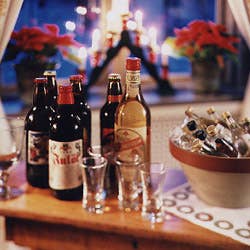
Sweden’s Water Of Life
Aquavit is as integral to a Swedish smorgasbord as herring or meatballs. The strong, warming alcohol holds a special spot in the hearts of the Swedes—who are apt to belt out odes to it while tossing it back, even in the finest restaurants. Somewhere, down there," one song goes, "in my stomach, in a dark and hidden spot, sits the Devil calling for another shot."
The potion dates back to the 1400s, when it was first made by infusing distilled wine with herbs. This brenth wiin ("burnt wine"), as it was called, was used as an elixir, thought to cure everything from toothache to infertility. Wine was imported and expensive, however, and in the 17th century, the Swedes discovered that they could also distill a mash of grain—considerably cheaper—into alcohol; in the 18th century, they started using potatoes for the purpose as well. Today, these spirits are known as aquavit—"water of life"—which usually means neutral alcohol made from potatoes or grain and infused with a variety of herbs and flavorings; cumin, fennel, St. John's wort, and wormwood bitters are typical.
By 1756, there were about 180,000 home stills (roughly one for every ten inhabitants) producing aquavit in Sweden. The Swedish Temperance Society managed to get home distilling banned in the 19th century, and in 1917, the government bought all the country's commercial distilleries, making alcohol a state monopoly. When Sweden joined the European Union in 1995, the law changed, and today private firms can make or import spirits—though they may still be sold only in state-run stores or directly to restaurants.
Keep Reading
Continue to Next Story










